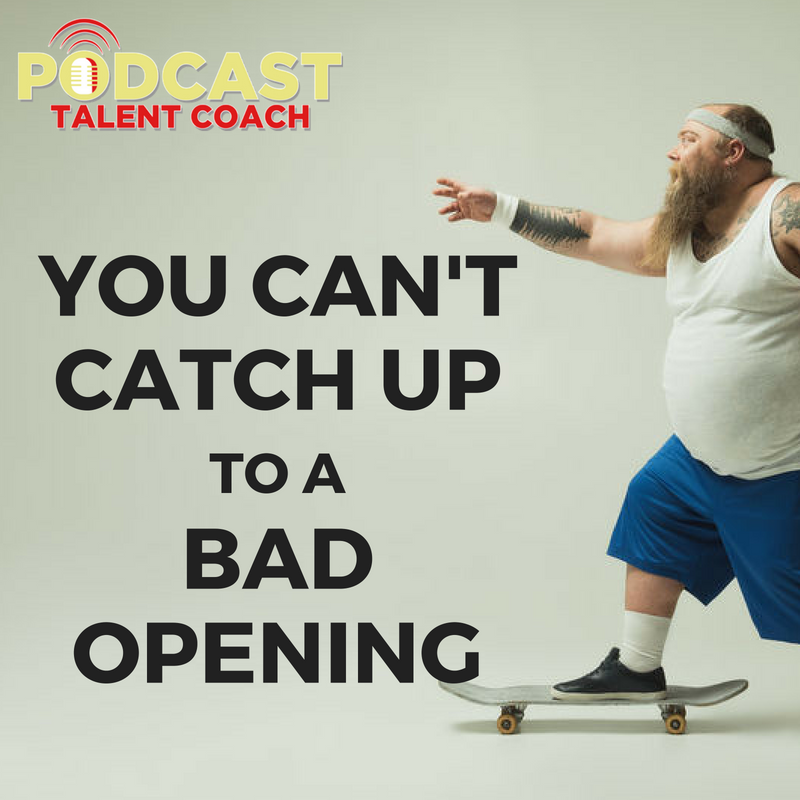Podcast: Play in new window | Download
Subscribe: RSS
Can’t Catch Up To A Bad Opening – Episode 202

Start strong. You can’t catch up to a bad opening. You work hard to get your audience to push play on your podcast. Don’t risk losing them by wandering into your content. Create a powerful introduction to hook their attention.
At Podcast Movement 2017, I saw a presentation given by Steve Goldstein. He has a great background in broadcasting. Goldstein has now moved into podcasting. He runs Amplifi Media.
The presentation given by Goldstein offered a lot of data he gathered during a study of regular podcast listeners. This data provided great insight into the habits of people who regularly consumed podcasts.
One of the interesting facts centered on tune out. After pushing play, at what point do podcasters leave a podcast? How long do you have to capture their attention?
The study showed that most listeners leave a podcast within the first five minutes if they are not engaged in the content.
Five minutes.
In the first five minutes of your show, are you truly capturing the attention of your listener?
There are three introductions each episode should include in order to engage. You need to introduce the podcast. You need to introduce the episode. Finally, you need to introduce each segment.
SHOW
When you open the podcast, tell listeners exactly why they are here. Explain the benefits of the show. What is in it for the listener?
When someone discovers your podcast, it is likely they will listen to the most recent episode. Therefore, you cannot assume they have listened to every episode up to this point. Quickly bring them up to speed on the show.
Your show is like a cocktail party. When someone arrives a couple hours after the party has begun, you need to welcome them with a solid handshake. Then, you need to tell them everything they need to know to get up to speed.
You tell them where the food and drinks are located. You point out the restroom. You let your guest know where to put their coat. Finally, you make some quick introductions to key people at the event.
The same is true for your show. If I am new here, tell me what I need to know to understand the show. Introduce the players and explain their roles. Explain the purpose of the show. Fill me in on the customs and lingo of the podcast.
EPISODE
Once we have explained the show, we need to describe what makes this episode special. Why should I listen to this particular episode? Tell your listener the one benefit they will get by consuming this specific show.
Then, get to the point.
SEGMENT
As you roll through the various parts of the show, tell the listener exactly what they should take from each particular segment. Lead with a strong headline.
Every transition to a new segment is an opportunity for your listener to leave. The more time you waste, the more chance they will eject. Make your transitions quick and clean.
If you interview guests, start strong. Remember that it is your job to introduce the guest. It is not your guest’s responsibility to tell the audience what they need to know.
Find the three most important things that give your guest authority and explain to your audience why they should care. Include those three things in your introduction of the guest. Then, ask a strong question.
Do not start with, “Tell me a little about yourself.” You know your listeners and what they need to know. Your guest does not. Do your job.
Get your guest to drop the script by leading with their plug. “My guest has helped thousands of people [BENEFIT]. You can find her at [WEBSITE]. She has a new book out called [TITLE]. Please welcome [NAME].”
When you give the plug up front, your guest doesn’t need to worry about getting it in. We can now have a conversation.
Goldstein’s PM17 presentation also showed that only 47% listen to the full episode. That means over half of your listeners do not reach the end of your show. You are doing your guest a disservice if you wait to the end.
You are also shorting yourself if you wait until the end of your show to make your own call-to-action. Make it short near the top of the show. Tease that you will provide greater detail later in the episode.
Make each introduction within the show as strong as possible. You can’t catch up to a bad opening. You need to introduce the podcast, the episode and each segment within the show.
Do you need help with your podcast? E-mail me any time at Coach@PodcastTalentCoach.com. Let’s see what we can do.
You can find my podcast and other tools to help you create great content at www.PodcastTalentCoach.com.
Let’s turn your information into engaging entertainment.
